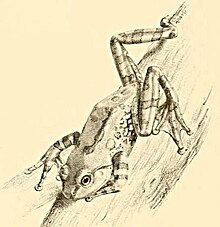Ghatixalus variabilis
| Ghatixalus variabilis | |
|---|---|

| |
| Scientific classification | |
| Domain: | Eukaryota |
| Kingdom: | Animalia |
| Phylum: | Chordata |
| Class: | Amphibia |
| Order: | Anura |
| Family: | Rhacophoridae |
| Genus: | Ghatixalus |
| Species: | G. variabilis
|
| Binomial name | |
| Ghatixalus variabilis (Jerdon, 1854)
| |
| Synonyms | |
|
Polypedates variabilis Jerdon, 1854 | |
Ghatixalus variabilis is a species of frog in the family Rhacophoridae. It is endemic to the Western Ghats of southern India.[2] It has a number of common names, including green tree frog,[2] though it is terrestrial rather than arboreal in its life style.[3]
Description
Male Ghatixalus variabilis grow to a snout-vent length of 41–51 mm (1.6–2.0 in) and females to about 67 mm (2.6 in). Males have nuptial spines. The colour is variable, even within a single location. The dorsum has a colour pattern characterized by prominent dark brown blotches.[3]
Ghatixalus variabilis build spherical foams nests that are suspended up to 3 m (9.8 ft) above the water. Tadpoles hatch within the foam and drop to the water after a few days.[3]

Habitat and distribution
Ghatixalus variabilis is only known from the Nilgiri hills (a part of the Western Ghats), Tamil Nadu, India. They are found in evergreen montane forest patches at high altitudes. They are only found very near mountain streams, either on ground or low in the vegetation. When disturbed they escape to the water.[1][3]
Their habitat is threatened by fragmentation due to agricultural and logging activities as well as rural and/or urban development.[1]
References
- ^ a b c S.D. Biju, Sushil Dutta, Karthikeyan Vasudevan, Chelmala Srinivasulu, Ariadne Angulo (2010). "Ghatixalus variabilis". IUCN Red List of Threatened Species. 2010: e.T59027A11872030. doi:10.2305/IUCN.UK.2004.RLTS.T59027A11872030.en. Retrieved 15 November 2021.
{{cite journal}}: CS1 maint: multiple names: authors list (link) - ^ a b c Frost, Darrel R. (2016). "Ghatixalus variabilis (Jerdon, 1854)". Amphibian Species of the World: an Online Reference. Version 6.0. American Museum of Natural History. Retrieved 3 October 2016.
- ^ a b c d Biju, S.; Roelants, K.; Bossuyt, F. (2008). "Phylogenetic position of the montane treefrog Polypedates variabilis Jerdon, 1853 (Anura: Rhacophoridae), and description of a related species". Organisms Diversity & Evolution. 8 (4): 267–276. doi:10.1016/j.ode.2007.11.004.
- ^ Günther, Albert C. L. G. (1864). The Reptiles of British India. Ray Society (Series) No. 35. London: R. Hardwicke.

